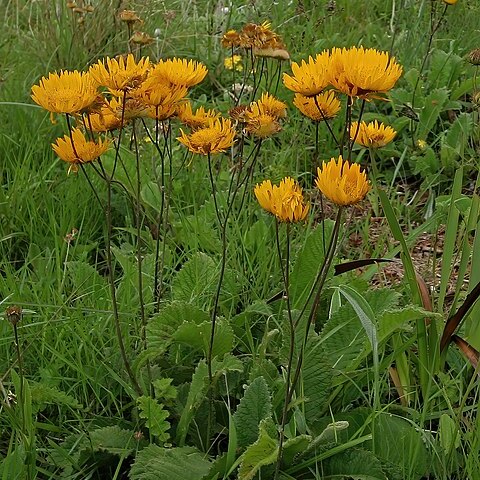Perennial herb, up to 1.2 m high. Stems erect, single, not winged. Leaves alternate; mostly basal, occasionally 1 or 2 small leaves along stem; blade of basal leaves elliptic to broadly elliptic or obovate to narrowly obovate, up to 400 x 120 mm, apex rounded to subobtuse, base narrowed into petiole, not decurrent, margins entire to coarsely but shallowly dentate, upper surface and margins with harsh, straw-coloured bristles, lower surface softly hairy; stem leaves in lower half, much smaller, sessile. Heads few, radiate, ± 60 mm in diameter, clustered on long peduncles. Involucral bracts connate at base, linear, acuminate, ± 1 mm wide, apex and margins spiny, minutely glandular-pubescent and pilose-araneose on backs. Flowers: ray and disc florets bright golden-yellow; Nov.-Feb. Fruit with cypsela turbinate, pilose, ± 2.5 mm long. Pappus of scales, bi-or triseriate, up to 12 mm long, narrow, linear, acuminate.
A perennial herb with a stout woody stock, flowering stem terminal, solitary, up to 120 cm tall, harshly pubescent, simple below, commonly forking above to bear several heads on long peduncles, upper stem nude or with a few reduced leaves or bracts. Leaves few, radical or sub-radical, up to 40 x 12 cm, but often only about half that size, obovate to lanceolate-obovate, tapering to a petiole-like clasping base, apex rounded or obtuse, margins entire to coarsely but shallowly toothed, subspinose, setose, upper surface rough with coarse, straw-coloured bristles, lower cobwebby when young, later harshly pubescent. Heads c. 6 cm across the expanded rays. Involucral bracts linear-lanceolate, acuminate, c. 1 mm broad, tips and margins spiny, minutely glandular-pubescent on the backs. Flowers bright golden yellow. Achenes c. 2 mm long, turbinate, pilose. Pappus scales up to 12 mm long, narrow, acuminate.
Perennial herb, 0.6-1.2 m high; from stout woody rootstock; stems single, erect, branched above, glabrous or thinly pilose-araneose. Leaves mostly basal with 1-several cauline leaves diminishing in size to stem apex, not decurrent on stem; basal leaves ascending-subrosulate, obovate to oblanceolate, apex rounded or subobtuse, margins subentire to dentate or sinuate-dentate. Capitula radiate, solitary and terminal on branches or several clustered; involucral bracts linear-tapering to a spinescent apex, spinescent-ciliate on margins and pilose-araneose on back. Receptacle: alveolate, margins with spinescent setae. Ray florets yellow. Disc florets many; yellow. Flowering time Dec.-Mar. Pappus 2-or 3-seriate, of narrow, paleaceous, barbellate setae. Cypselae turbinate, 8-10-ribbed, hispid-strigose.
Leaves mostly basal with 1-several cauline leaves diminishing in size to the stem apex, not decurrent on the stem; basal leaves ascending-subrosulate, 10–45 x 4–12 cm., obovate to oblanceolate, apex rounded or subobtuse, base ± long-tapering becoming petiole-like, dilated and somewhat stem clasping, margins subentire to dentate or sinuate-dentate, upper surface and margins beset with patent stramineous spine-like bristles 2–7 mm. long, the longest at tooth apices, lower surface indumentum as for stem; cauline leaves few, becoming bract-like at the stem apex.
A herb. It can grow up to 1.2 m high. It keeps growing from year to year. It puts up annual stems. The stems have a covering of hairs. The leaves are mainly near the base with smaller leaves on the stems. They are broadly oval and 45 cm long. They have spiny bristles on them. The leaves narrow towards the base. The flower head is at the top of the plant. It is 3-6 cm across. They are yellow.
Phyllaries from c. 4 mm. long in the outer series to c. 12 mm. long in the inner series, mostly c. 1 mm. wide at the base and linear-tapering to a spinescent apex, spinescent-ciliate on the margins and pilose-araneose on the back; the inner ± unarmed.
Perennial herb, up to 1.2 m high. Stems not winged. Leaves radical, obovate to lanceolate-obovate, upper surface with straw-coloured bristles. Heads radiate. Flowers bright golden yellow; September to February and in May.
Disk-florets numerous; limb yellow, c. 13 mm. long from the tubular lower half; achenes 2–3 mm. long, turbinate, 8–10-ribbed, hispid-strigose; pappus 2–3-seriate, of narrow paleaceous barbellate setae, 8–10 mm. long.
Capitula radiate, solitary and terminal on the branches or several ± clustered, 3–6 cm. in diam. across the expanded rays.
A perennial herb up to c. 120 cm. tall, from a stout woody rootstock (? with root tubers).
Stems annual single erect ± branched above, glabrous or thinly pilose-araneose.
Receptacular alveolae margins with spinescent setae to c. 6 mm. long.
Rays yellow, mostly 12–20 x 1.5–4 mm.

